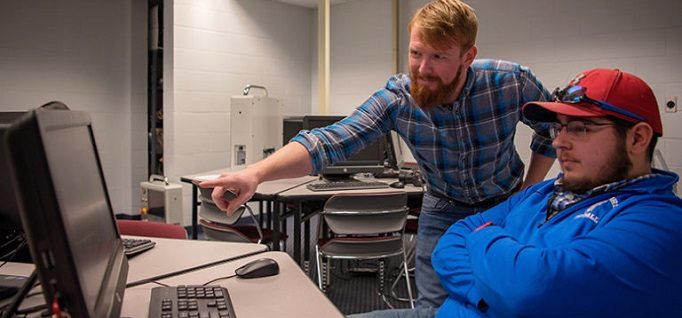A magnet for manufacturers
By Joan Mooney
February 23, 2022
Community colleges have long worked with local companies to fulfill their workforce training needs. Now the colleges’ role has moved up to the next level, as they help persuade companies to locate new large-scale, high-tech manufacturing plants near them.
“We used to be looked to for preparing job seekers,” said Joe Schaffer, president of Laramie County Community College in Wyoming and a member of the American Association of Community Colleges (AACC) board of directors. “Now, we’re looked to for how to stimulate and spur economic development.”
It’s a big expansion of community colleges’ role, but in many places – including in rural America, where new jobs are especially needed – the colleges have come through, working with state and sometimes federal partners.
Intel in Ohio
The biggest recent example is Intel, which announced in January it would invest more than $20 billion to build two new factories for advanced microchip manufacturing in the Columbus, Ohio, area. Intel calls it the largest private-sector investment in Ohio history, with the initial phase expected to create 3,000 Intel jobs and 7,000 construction jobs, plus tens of thousands of additional local jobs.
All those jobs will need training. That’s where community colleges come in.
“A handful of community colleges are working directly with Intel,” said Jack Hershey, president of the Ohio Association of Community Colleges. As for the rest, “140 companies signed agreements with Intel to be part of the supply chain in every county in Ohio. So every community college has a relationship with the supply chain.
“Twenty to 30 companies are coming to locate in Ohio,” he said. “That’s 10,000 jobs. This is the kind of thing we’ve never seen before. It’s going to require us as a group of community colleges to work together collaboratively.”
As for the Intel jobs, at least 60% require an associate degree or certificate, Hershey said. “The industrial side – this is our bread and butter,” he said.
At the Intel announcement – which was attended by President Joe Biden to show the importance of U.S. investment in microchips – Ohio’s U.S. senators, the state commerce secretary and lieutenant governor all highlighted the strength of the higher education system in Ohio.
“People were bending over backward to talk about community colleges,” Hershey said.
Embracing diversity
Intel has praised the diversity of community colleges’ student body, said Hershey. The company “is looking to embrace that in their corporate culture.”
The presidents of Central Ohio Technical College and Columbus State Community College have been working together on how they can help Intel.
“They understand there’s more food at the table than any one [college] can eat,” Hershey said.
Columbus State President David Harrison has been in the lead, talking to Intel since early fall.
“The very first meeting I was in was [about] the commitment to diversity,” Harrison said. “There’s an appreciation for all that community colleges provide. Most of the jobs are community college jobs.”
Intel has promised to invest $100 million in higher education in Ohio.
“Intel is thinking big and wants to do it as soon as possible,” said Harrison. “This is a priority for the federal government. That gives Intel the confidence.”
Harrison is confident, too, about the role that Columbus State and other community colleges can play.
“We have strong manufacturing programs now,” he said. “The automotive industry, metals industry – some of those are likely to be transferable to chipmaking and the advanced technology associated with that.
“We’re going to need significant infrastructure. We’ll work with Intel,” he added.
Intel is working with the National Science Foundation. The CHIPS Act (Creating Helpful Incentives to Produce Semiconductors for America Act, H.R. 7178) will provide venture capital.
The supply side
Jo Alice Blondin, president of Clark State College in Springfield, Ohio, is focused on supply chain opportunities with the college’s manufacturing programs and training for commercial driver’s licenses.
“We can do it, but we will need to collaborate,” Blondin said. “It’s a once-in-a-lifetime opportunity for a community college anywhere, and there are 23 community colleges in the state of Ohio.”
Ohio colleges are waiting for requests for proposals from Intel detailing what the company needs.
“Community colleges’ middle name is responsiveness,” Blondin said. “When we get a very clear picture of what their needs are, we will all respond.”
She said community colleges have a good relationship with four-year colleges in the state, and that they will all need to collaborate.
There’s more to the story! Read the full article in CC Daily.



